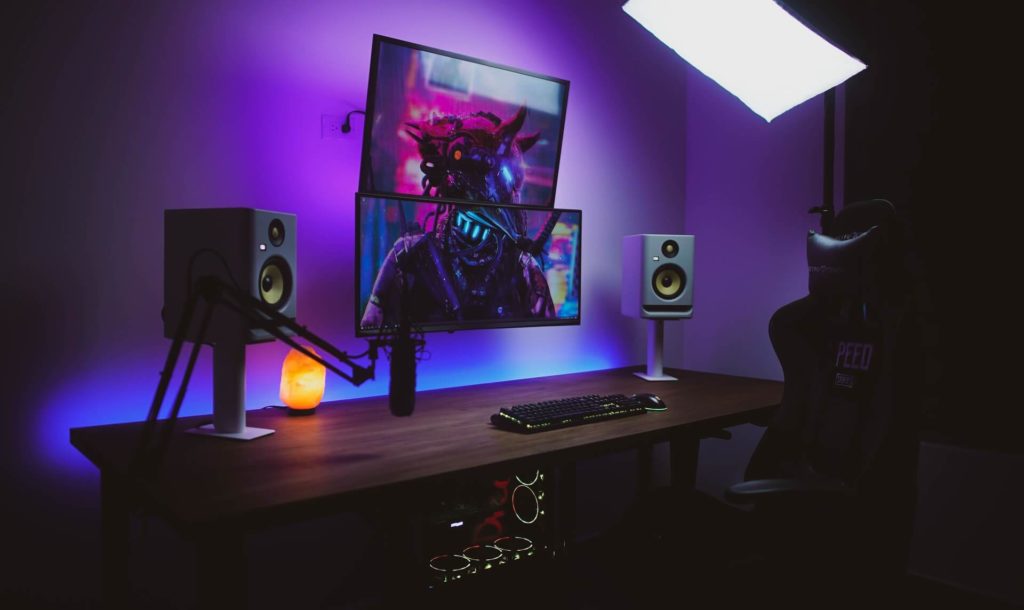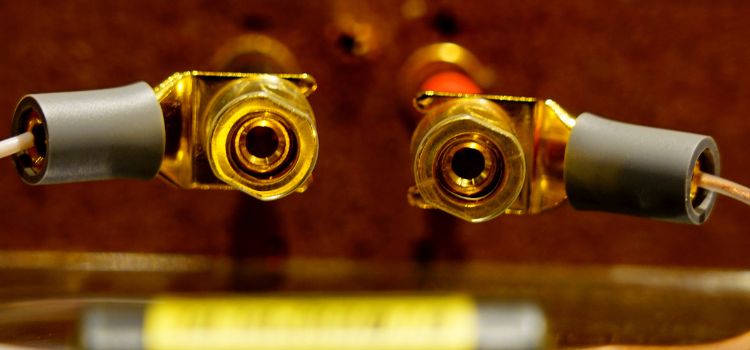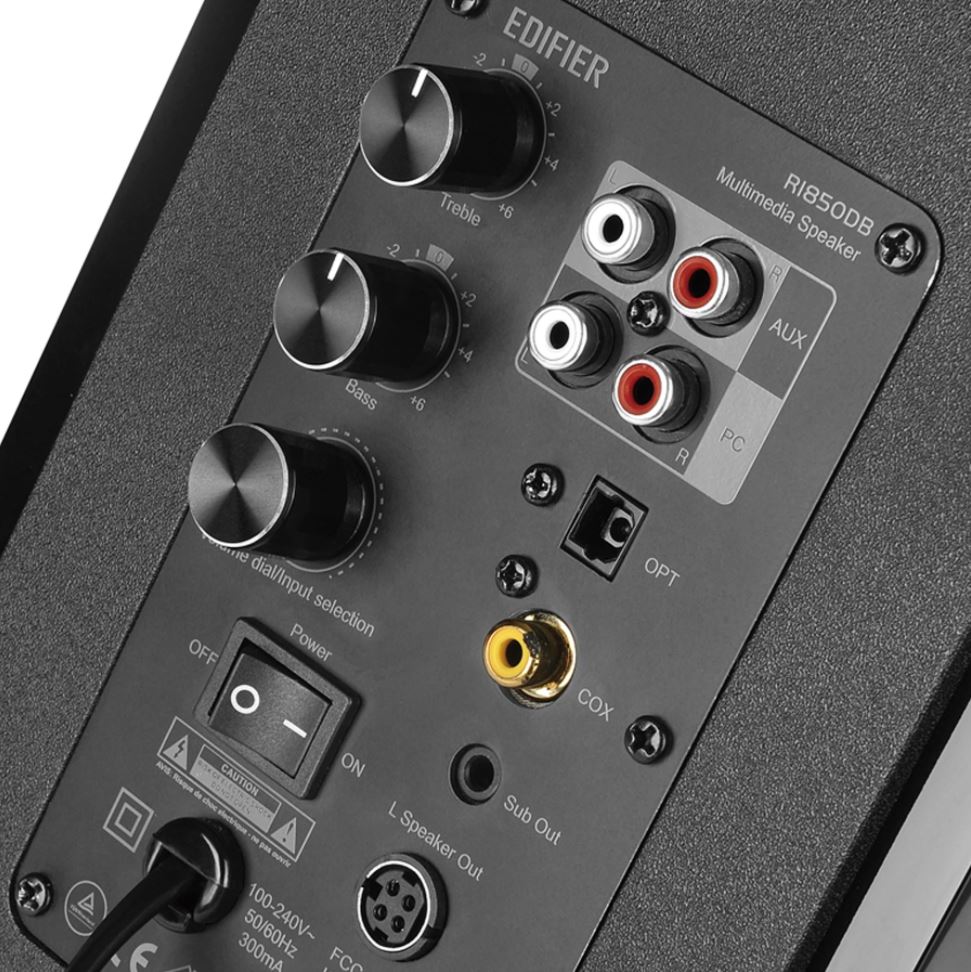Bookshelf speakers can make the perfect computer speakers. Connecting bookshelf speakers to your computer isn’t always straightforward though. We’ll walk you through the process and explain how to hook bookshelf speakers up to your PC. The instructions will vary depending on the type of bookshelf speaker you have, so feel free to skip ahead to the relevant section.
Table of Contents
Connecting Bookshelf Speakers To Computer: Wired vs Wireless

If you have passive or wired bookshelf speakers, the process of connecting them to a computer is a little more complex. Passive bookshelf speakers do not have their own power supply or connectivity features. They are typically powered by a receiver or amplifier. Either product will provide power to passive bookshelf speakers via speaker wire. You can utilize bare speaker wire or buy banana plugs. Your computer will then need to connect to the amplifier or receiver to send an audio signal. We’ll explain your connectivity options for both.
On the other hand, wireless or active speakers will have power and multiple connectivity options onboard. For example, many active speakers include Bluetooth connectivity with no cables required for audio playback. Those who want to listen to lossless audio will likely prefer to use a speaker with RCA input. We’ll first walk through instructions for how to hook up passive speakers and bookshelf speakers.
How To Connect PC and Passive Bookshelf Speakers

The two most popular options for connecting passive bookshelf speakers to a computer are with an amplifier and receivers. A receiver will afford users more features, but are sometimes overkill for desktop purposes.
Connecting with an Amplifier
2 channel power amplifiers are the most straightforward solution for this use case. They are also less complicated and convenient for small desks. Especially if the bookshelf speakers are the only computer speakers you plan on using. The AIYIMA A07 is a 2 channel amplifier and the perfect example of the base functionality needed.
Equipment Needed For Connecting Computer and Passive Speakers To Amp
- Amplifier and Power Cable
- Passive Bookshelf Speakers
- Computer
- 3.5mm to RCA Cable
- Speaker Wire
Instructions
- Make sure amplifier is unplugged
- Connect each speaker wire to amplifier
- Each speaker wire has two separate wires
- Each speaker wire will be connected for left or right bookshelf speaker (Note the R/L marking on amp)
- The red-lined/positive side of each wire connects to the red input
- The negative side connects other speaker wire input (typically black or clear)
- Connect speaker wire to binding post of each bookshelf speaker
- The left speaker wire should connect to the left bookshelf speaker (same for right)
- Make sure the red/positive and negative wires also match on the speaker
- Connect the RCA end of cable into the amplifier input
- Red side of RCA cable should connect to red input (same for white)
- Connect the AUX end of the cable to your computer
- Plug in amplifier power cable
And you’re done! There are a few things to note about this setup. Amplifiers like receivers differ in their connectivity. The instructions above will work for most, as RCA cables are kind of the standard connection option. That makes a connection via 3.5mm to RCA cable a popular option. The aforementioned AIYIMA A07 and many other amplifiers also allow a direct AUX connection. Only an AUX cable would be needed in that case.
Many amplifiers like the Fosi Audio DA2120C include a Digital-to-analog converter (DAC) and extensive audio input options. Some also include a subwoofer-out line for an easy 2.1 setup. This is similar to a sub pre-out which allows you to send audio to an active subwoofer. This is perfect for those who want to add low frequencies and deep bass to their setup. You will typically need a subwoofer with bookshelf speakers for impactful bass.
Connecting speaker wire will be a very similar process for those amplifiers. You will just have more options of connecting your PC like Bluetooth. Bluetooth connectivity is convenient, but a wired connection will provide the best sound quality. RCA will still be most people’s best option for a wired connection to a PC.
Connecting PC and Passive Bookshelf Speakers With Receiver
The process of connecting speaker wiring to your receiver and passive bookshelf speakers is similar. A stereo or AV receiver will just provide more audio input options. They will also have many more features by default. That includes audio features like a DAC, codec support, phono input, radio, music streamer, etc. AV receivers are even more packed with features but are more geared toward home theater speakers. Many receivers also have the ability to power more than two speakers also. This may be unnecessary if you are on a tight budget. They are also larger and not a great fit if space is limited. There are smaller stereo receivers that are much more suited for this desktop application.
How To Connect PC to Active Bookshelf Speakers

Setting up a connection between your computer and powered bookshelf speakers is much more simple. Powered or active speakers have their own power supply thanks to a built-in amplifier. No need to play around with speaker wire, banana plugs, or binding posts. Once your active bookshelf speakers are powered on, connectivity options will vary based on each product.
The best active bookshelf speakers include a ton of connectivity options like Bluetooth, RCA, 3.5mm, Coaxial, etc. Powered speakers are a great option if you are looking for an affordable option. You won’t have to spend additional money on a separate amp. Many also come with convenient remote control. Active bookshelf speakers are your best bet for compact, quality computer speakers with a simple setup process.
Are My Bookshelf Speakers Passive or Active?
Turn each bookshelf speaker around. If you see binding posts with red and black inputs for speaker wires, you have passive bookshelf speakers. These are for connecting bare speaker wires, which will be the sole connection option for passive or wired speakers. This means they will need an external device for both power and connectivity. This typically means an amplifier, receiver, or both.
If you have active or wireless bookshelf speakers, you will see a power plug and audio ports on the back panel. That’s because active speakers have an internal amplifier and connectivity option on board. They will be capable of receiving an audio signal directly from playback devices. Many active bookshelf speakers also have onboard controls to adjust treble, bass, and volume.
Conclusion: How To Use Bookshelf Speakers With PC
Everybody knows audio on computers is typically subpar. People usually want to improve sound quality whether they are listening to music or watching Youtube videos. Buying bookshelf speakers is the simplest way to elevate your listening experience. As long as you can connect them properly. We hope our instructions provided the perfect blueprint.
For recommendations on bookshelf speakers, check out our top bookshelf speakers under $500. Buyers seeking simplicity when connecting bookshelf speakers to a computer or phone should opt for active speakers. Active speakers will make installation and set up much more convenient.
PC & Bookshelf Speaker Connections: FAQs
What Is The Best Way To Connect Speakers To PC?
The most convenient option is a Bluetooth connection to active bookshelf speakers. For the best sound quality, a lossless connection with a cable is the best option for any type of speaker. Since most PCs have 3.5mm AUX ports, an RCA to 3.5mm cable is ideal.
Will Speakers Connected To A Computer Sound Good?
Computers are capable of providing good sound quality. Users should also experiment with bypassing the DAC on their PC for improved sound quality. While less popular, amplifiers that can receive USB-C input from a PC are the best option for this purpose.
Can I Connect Speakers Directly To My Computer?
Only active or wireless speakers can be connected directly to your computer. A passive speaker will require an amp or receiver to faciliate a speaker wire connection. The amp or receiver must then me connected to the computer.

Keith Collins has been writing for over 15 years for various publications. He’s a lover of music, home theater, and excellent sound quality. His fondness for technology in addition to his non-stop curiosity fuels his writing ventures.






